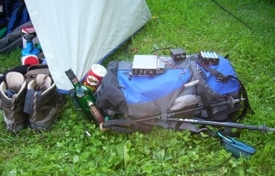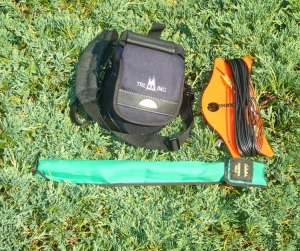
|
|
QRP Portable Operations |
In my experience, one should be clear regarding the objectives of carrying a rig along on a hike. Unless the primary goal is to operate from a specific location, I tend to find the rig to be an unwanted distraction and excess weight to carry. I used to carry a 2m HT as I thought it could be useful for emergencies, but had visions of some lid asking me for a SOTA or grid number or similar trivia, so gave that up.
A useful addition would be to make to make a small, lightweight collapsible operating table to fit in my backpack. Using the backpack itself or wet grass as a table isn't very satisfactory.
The big advantage of operating outdoors is that there is plenty of room to erect antennas. I can never understand why some QRPers handicap themselves with inefficient shortened antennas when in the field. If operating solely on 20 metres, my normal antenna is an end-fed halfwave. This is quick and easy to erect and I normally configure it as a sloper. This only requires one support, which is normally supplied by a friendly tree. If above the treeline or elsewhere devoid of trees, I have a Cabelas 14ft Panrod which is lightweight and collapses to quite a short length. I use velcro straps to attach the fishing rod to a signpost or other suitable support to achieve more height.
On 40m, I normally use a dipole, fed with RG174U, which can be erected quickly at a low height and is very effective for NVIS operation. I can easily make contacts around Europe with 3 watts on 40 metres. For reliability, the RG174U feeder is terminated with a phono plug and I use a phono-BNC adapter to connect to the DSW-II Antenna socket. This removes the worry of a BNC plug failing in the field, as the ones designed for use on RG174U don't look too sturdy.
For lightness and strength, the wire antennas use 26awg copperclad steel wire (type #534) from The Wireman. To prevent tangles on this type of wire, I've found G3CWI's Wire Winders to be very effective.
40m portable QRP station using DSWII | |
 
40m portable station packed in camera bag, with 40m Dipole and 14ft Crappie Rod |
 
Contents of bag include the DSW-II, Palm paddles, earbuds, logbook & battery pack |